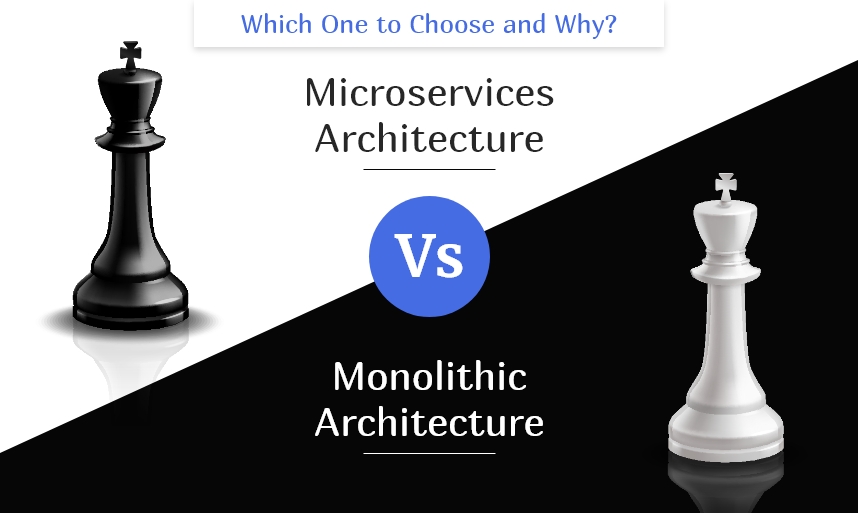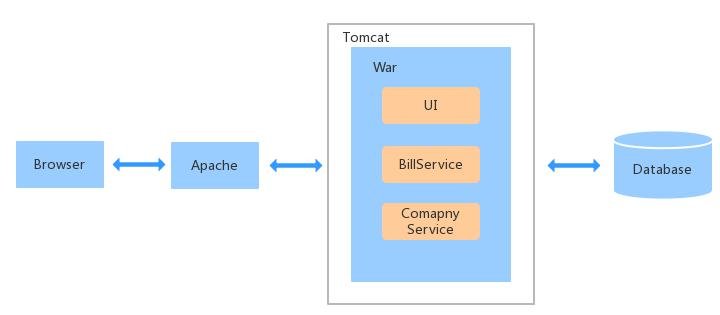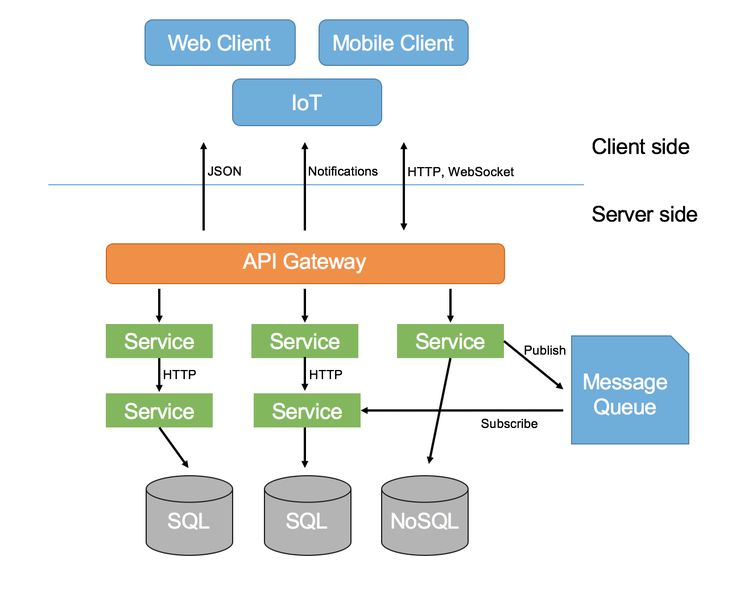Monolithic Architecture and Microservices Architecture
 Frank Idugboe
Frank IdugboeTable of contents
- Introduction
- Monolithic Architecture
- The advantages include:
- 1.Evolution of applications is simple
- 2. Customizations and overarching concerns are only utilized once
- 3.Ease of integrating new team members
- 4.Early on in the application, costs are low
- 5.Ease of development
- 6.Debugging is easy
- 7.Testing simplicity
- 8.Deployment simplicity
- The disadvantages include:
- 1.Tight coupling between services (interdependencies)
- 2.Code ownership is inapplicable
- 3.Problems with performance
- 4.Infrastructure costs money
- 5.Technologies from the past
- 6.Lack of adaptability
- 7.There are deployment issues
- Microservices Architecture
- The advantages include:
- 1.Microservices are easier to test
- 2.You can reuse code and build up libraries of functionality with microservices
- 3.You can move faster as a company with microservices
- 4.Development time and cost were reduced
- 5. Each module is deployed independently
- The disadvantages include:
- 1. Increasing complexity
- 2. Global testing and debugging is challenging
- 3. Not suitable for small applications
- 4. Microservices Can Pose Security Risks
- Conclusion

Introduction
When you're building a large-scale application, there are many different ways to go about it. While there is no "right" way to do things, I think it's useful to know the tradeoffs that each option presents. That way you can make an informed decision about which approach would be best for your particular use case. In this post I'm going to compare monoliths and microservices so that you can decide whether or not they make sense for your project.
Monolithic Architecture
Monolith applications are all-in-one apps.
A monolith application is an all-in-one app. It typically has all the features in a single codebase written in a single programming language and technology stack. For example, if you were building an online store for selling t-shirts, you might have one application that handles checkout, payments, inventory management and updating orders.
Monolith applications are easier to build and deploy because they’re made up of fewer components than microservices. However, this simplicity comes at the cost of having more complex interactions between these components which can make it difficult to scale them as your business grows or adapts to changing requirements (for example when new features are added).
Monolith applications are not always a bad thing. For simple applications, they can be ideal. In fact, in the early days of software development there was no such thing as microservices. Our first computers were monolithic machines that could only perform one task at a time (think calculators). When we started using personal computers and eventually mobile devices, our computing power dramatically increased but we still had only one application running on our machine at once—the OS itself was still monolithic in nature.
Monolithic-architecture-diagram
Monoliths have their place but they might not be ideal for every application you build today or tomorrow. For example:
If your app has lots of data associated with each user record and you run into performance issues with large datasets from too many database queries being executed too quickly (this is called "queries per second"), then breaking up your user records into separate entities that can be queried individually might help address those problems by reducing how many queries are performed against each database table's rows at any given time...
Monoliths are ok for some applications, but for more complex systems you may want to go ahead and break it down into microservices.
The advantages include:
1.Evolution of applications is simple
From a business logic standpoint, the application really has no restrictions. It is already there if you require certain data for a new functionality.
2. Customizations and overarching concerns are only utilized once
Cross-cutting issues should only be handled once. For instance, setting up a data source connection pool, choosing and configuring Tomcat parameters, security, logging, managing exceptions, monitoring, etc.
3.Ease of integrating new team members
One location houses all of the source code. New team members can quickly become familiar with the application and debug certain functional flow.
4.Early on in the application, costs are low
One deployment unit, containing all of the source code, is created, packed, and deployed. What could be simpler? Infrastructure or development if you need any.
5.Ease of development
One common method of creating apps is the monolithic approach. No other information is needed. There is a central location for all the source code that makes it easy to understand.
6.Debugging is easy
Since all of the code is in one location, debugging is easy. Finding an issue by following a request's flow is simple.
7.Testing simplicity
You test a single service independently of any dependencies. Usually, everything is obvious.
8.Deployment simplicity
It is recommended to deploy just one deployment unit (such a jar file). There aren't any reliance. There are no breaking changes when the UI is packed with the backend code. Everything is located in one area and changes there.
Once the application is successful, monolithic architecture issues start to show up. The growth of the application is the very straightforward cause of this. The following reasons are often why a monolithic application transforms into another after some time.
The disadvantages include:
1.Tight coupling between services (interdependencies)
If you change something in one service, it could break another service’s functionality because they were tightly coupled together without any abstraction layers in between them (e.g., no interfaces between them).
2.Code ownership is inapplicable
The structure is expanding. The logical next step is to distribute duties among various teams. For instance, one team could concentrate on flight service while another would work on billing service. There are no distinctions between those services, though. Teams can influence one another.
3.Problems with performance
In the event of a performance problem, you may be able to scale the entire monolithic service. But what about the database? All services rely on a single database. You can begin by optimizing your database queries or by using read replicas. This type of optimization, however, has a limit.
4.Infrastructure costs money
In cases of poor performance, you should scale the entire monolithic service. It adds to the cost of application operability.
5.Technologies from the past
Assume your application is written in Node.js 11.2.0 How long will it take to migrate the entire monolith with multiple services underneath to Node.js 18.0.0? What should be done with the tasks required to add new functionality? It is possible that the application will never be migrated.
6.Lack of adaptability
When you use Monolithic Architecture, you are limited to the technologies that are used within your monolith. Other tools cannot be used, even if they are better suited to the problem at hand.
7.There are deployment issues
Even minor changes necessitate the redeployment of the entire monolith.
Microservices Architecture
Microservices are all-in-one apps that have been broken down into smaller chunks.
Microservices are all-in-one apps that have been broken down into smaller chunks. This is different from a monolith, which is an application written in one language and operated together as one unit of code.
Microservices architecture is a contemporary approach to developing software applications from a collection of individual modules (services). Each service is typically focused on a single task (payment, shipping, etc.) or business function and can be built using a unique set of technologies.
This provides agility for both the engineering teams and the business as a whole. Microservices-based applications, for example, are easier to scale. Individual services are frequently quicker to develop and deploy than monolithic applications. And the benefits of microservices don't stop there.
Microservices-architecture-diagram
Companies using Microservices There are many companies using Microservices for their products and services and here is a list of a few who shared their experiences. They are : Comcast Cable, Uber, Netflix, Amazon, eBay, Sound Cloud, Karma, Microsoft Groupon, Hailo, Gilt, Zalando, Lending Club, AutoScout24 etc
Let's dig deeper into these and other advantages of microservices. You'll see how this approach helps businesses build long-lasting, high-performance applications, reduce time to market, and effectively adapt to change.
The advantages include:
1.Microservices are easier to test
You can test and change smaller pieces of a system, you can test a microservice without having to test the whole system. You don't have to bring up all of your instances just so that you can run some tests on one small piece. You also don't have to worry about breaking the rest of your application when trying out new functionality or fixing bugs in an individual microservice. This makes it much easier for developers since they can focus on their own part of the project without being concerned with how it will affect other parts of the project or whether something else might break because they're touching it at all.
2.You can reuse code and build up libraries of functionality with microservices
You can reuse code between microservices, and build up libraries of functionality that can be shared between services. This means you can build out highly specialized functionality for a single service, and then use that same code in other places. This is why people like to talk about "monoliths" as being monolithic—they're so big it's hard to change them, and because they're so big it's hard to break them apart into smaller pieces.
3.You can move faster as a company with microservices
The microservices approach allows you to focus on one thing at a time. It lets you use more people and more tools, making it easier to move fast without sacrificing quality. Microservices allow you to be more agile, flexible, and iterate quickly because they're modular by nature. Each service has its own codebase, which makes them easy to update or replace if necessary.
4.Development time and cost were reduced
Despite the significant costs associated with establishing an agile team and microservices infrastructure, this approach is widely recognized as a significant source of savings, particularly in the long run. We've already mentioned several advantages that have a direct impact on the bottom line: faster time to market, lower costs for upgrading and scaling the system, and so on. Furthermore, the adaptability of microservices has an impact on team structure. It enables the use of the dedicated team model to create agile teams – both in-house and remote – responsible for specific modules or business functions. These teams can collaborate in parallel, increasing productivity and delivery speed.
5. Each module is deployed independently
Microservices can be deployed independently in any application because they are separate modules. If any module is changed, the entire application does not need to be rebuilt and deployed. Smaller codebases result in easier and faster deployment. This is due to the fact that there are fewer dependencies to manage within the services. Continuous deployment is also made possible by the independent deployment of individual services. As a result, the software is always up to date for users.
The disadvantages include:
1. Increasing complexity
API-driven service-oriented architecture has many structural parts. Therefore, it takes more resources to support the system and keep it running. It may also require a more complex testing strategy as services have little in common and require individual testing and debugging. Despite these challenges, multiple advantages of microservices as well as real-world experience and proven bottom-line benefits encourage companies to shift towards microservices and further invest in this approach.
2. Global testing and debugging is challenging
When compared to microservice-based software, testing a monolithic application is significantly easier. All that remains is for us to launch our app and ensure and test its connection to the underlying database. Each service in a microservices-based application must be launched and tested separately first. After all of the services have been launched, the application as a whole must be tested again.
3. Not suitable for small applications
Microservices architecture is an excellent choice for larger applications. However, for smaller apps, it will most likely be more time consuming and difficult to implement.
4. Microservices Can Pose Security Risks
Microservices pose significant security challenges when compared to monolithic applications due to the significant increase in the volume of data exchanged between modules, because you're using multiple small containers, you're exposing more of your system to the network, which means more of your order is vulnerable to potential attackers. It's also worth noting that because containers are highly replicable, a flaw in one module can quickly escalate into a larger issue. The source code is frequently used across multiple applications, providing hackers with easy access. As a result, if the proper tools and training are not used, microservices can quickly become a security nightmare.
Conclusion
Monolithic architecture is ideal for small applications due to its rapid development, ease of testing and debugging, and low cost. However, as the system grows, it may become an impediment to business and should evolve into a different form.
As you can see, there are numerous benefits to using microservices. They enable you to create more modular and maintainable applications, with less risk of breaking things when you make changes. They also provide your team with more flexibility in how they collaborate on a project, making it easier for them to be productive at all levels of experience—from junior developers to those who have been working with these types of systems for years.
Subscribe to my newsletter
Read articles from Frank Idugboe directly inside your inbox. Subscribe to the newsletter, and don't miss out.
Written by

Frank Idugboe
Frank Idugboe
I am an experienced Cloud/ DevOps professional with extensive practical experience in cloud architectural and infrastructure design in the Amazon Web Service environment. I also have the necessary skills to provide operationally excellent, competitively innovative, performance efficient, universally available, cost effective, reliable, secure, and fault tolerant infrastructure cloud computing solutions.